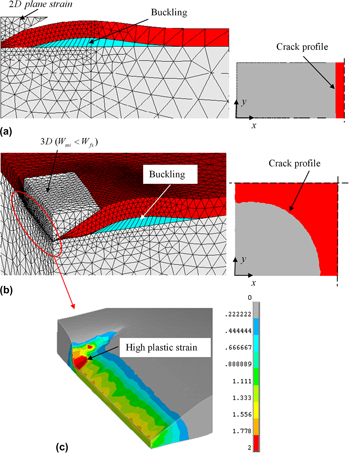Article contents
Interfacial delamination cracking shapes and stress states during wedge indentation in a soft-film-on-hard-substrate system—Computational simulation and experimental studies
Published online by Cambridge University Press: 11 August 2011
Abstract

The shapes of the interfacial delamination crack and stress states during wedge indentation in a soft-film-on-hard-substrate system were investigated systematically using the three-dimensional (3D) finite element simulation and wedge indentation experiment. In the simulation, a traction–separation law was used to characterize the failure behaviors of the interface. The effects of the wedge indenter tip length and the film thickness on the onset and growth of interfacial delamination were analyzed. It was shown that a two-dimensional (2D) to 3D transition of stress states occurred depending on the ratio of indenter length to film thickness. Furthermore, the interfacial delamination process by wedge indentation was conducted experimentally, and comparisons between the computational and experimental results yielded quantitative good agreement. Finally, a straightforward criterion based on the curvature of the delamination crack front was proposed to indicate the transition of stress states during the interfacial delamination. A guideline was therefore proposed to classify the 2D and 3D stress states for extracting the interface adhesion properties.
Keywords
Information
- Type
- Articles
- Information
- Copyright
- Copyright © Materials Research Society 2011
References
REFERENCES
- 5
- Cited by

